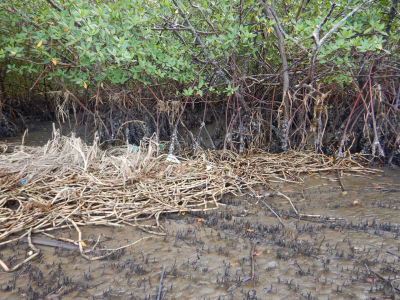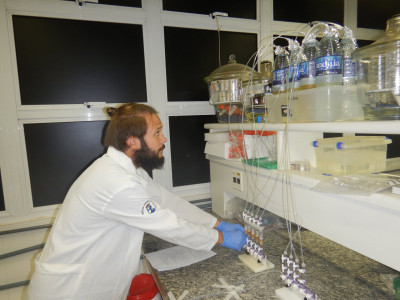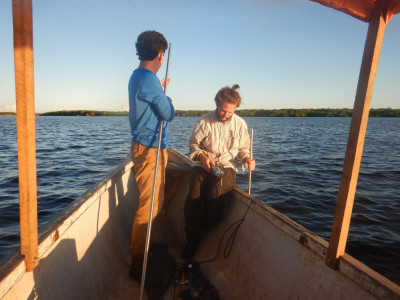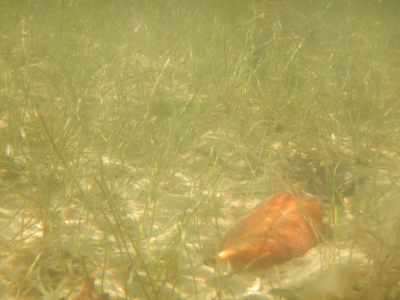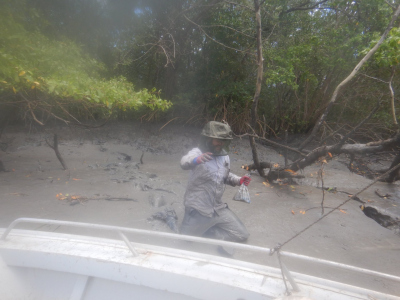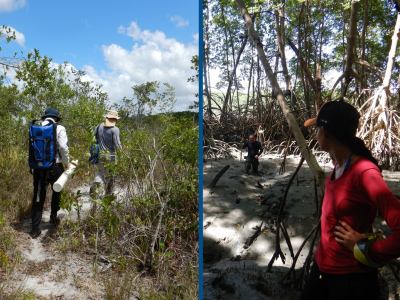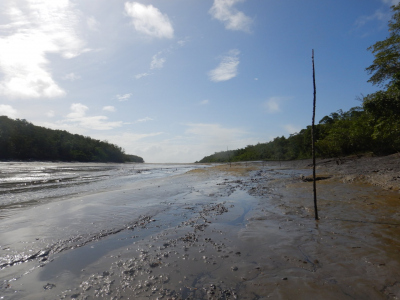- Graduate School GLOMAR
- PhD student reports
- Field Campaigns
- Mirco Wölfelschneider
Mirco Wölfelschneider
Report of GLOMAR PhD student Mirco Wölfelschneider about his field campaign in Salvador and Bragança, Brazil 2019 from 02 February to 08 June 2019 and 26 September to 04 December 2019
On the 2nd of February 2019 I arrived with my three large metal boxes full of research equipment in the city of Salvador in Northeast Brazil. That day the first of two field campaigns in which I would collect the samples for my PhD project started. My project is embedded in a larger project with the name ExManCoast - Exchange of organic matter between Mangroves and Coastal waters (https://www.leibniz-zmt.de/en/research/research-projects/exmancoast.html). It focuses on two different study sites in Brazil, one close to Salvador in the northeast and one close to Bragança in the north. At the two sites I’m investigating the organic matter dynamics in the coastal areas with a focus on the role of mangroves in the systems. For a sound baseline understanding on the dynamics the samplings where conducted at both sites during dry and rain season.
The first days in Salvador were mainly used to properly introduce myself and the project to our Brazilian colleagues, which supported me during our stay with everything needed in the laboratory and the field. A couple of days later, two colleagues from my work group, my first supervisor Dr. Martin Zimmer and another PhD student Guilherme Abuchahla, joined me for the first few weeks of the field campaign to get the work started and collect samples for their own projects. As soon as all equipment was checked, the material we had to buy on site was bought, and the additional student helpers were assembled, we started our journey to a little village with the melodious name Jaguaripe, - meaning little jaguar, which is located at the estuary of the eponymous river. The hotel “Pausada Jaguaripe” was then our home for the next couple of weeks. With the help of the team and Edison, a local fisherman who frequently works with researchers like us in the area, I collected and filtered water samples throughout the tidal cycles and along a grid across the whole estuary. Furthermore, we took sediment samples across the estuary and along transects in the mangrove belts fringing the Jaguaripe river, as well as leaf samples from the most common plant and algae species in the region. Back in the laboratory at the Federal University of Bahia (UFBA), I prepared the sediment and leaf samples together with the glass fiber filters, which we used to extract the particulate matter (PM) of the water samples. The extraction of the dissolved organic compounds from the filtrates concluded the first sampling during the dry season in Salvador.
After a fourteen-hour trip with a short stop-over in St. Paulo in Bragança, the second station of my field campaign. The time schedule here was with only four weeks much tighter and the sampling in the tidal channel and the estuary of the Caeté river across and along the peninsula of Ajuruteua had to start right away. Due to the more limited time and the sampling in two subareas I collected sediment, leaf, and water samples, which were only filtered for PM. After the samples of the rainy season were prepared for the transport, I already had to pack up my equipment and head back to Salvador, in order to arrive in time for the sampling during the rainy season there.
Back in Salvador the rainy season had already started and heralded the second sampling round for me in the state of Bahia. With the support of the researchers Dr. Vanessa Hatje, Dr. Francesco Barros, Dr. Nádia Roque, and Dr. José Marcos De Castro Nunes from the Federal University of Bahia (UFBA), and the students of Vanessa Hatje’s work group, both samplings in Salvador were a great success and I managed to acquire all samples and environmental data I wanted to collect. With the last samples dried I boarded the airplane back to Europe on the 8th of June 2019.
On the 26th of September 2019, about three months later, I once again started a project related journey to Brazil. The main focus of the second and last campaign of my PhD project was to conclude the sampling in the state of Pará. However, my first stop brought me back to Salvador, where I had to wrap up a few things and pick up some of the sampling material I stored there after the first campaign had ended. After that was done I traveled up north to Braganaça, were the sampling during the dry season was already waiting. The first half of the sampling mainly consisted of taking sediment samples across the estuary/tidal channel and along transects across the extensive mangrove forests of the Ajuruteuan peninsula, as well as collecting and filtering water samples throughout the tidal cycles and along a grid across the estuary and tidal channel. Throughout the second half I traveled to several terrestrial areas in the catchment of the Caeté, on the eastern side of the peninsula, and the planes that drain during the rainy season into the bay connected to the tidal channel, on the western side of the peninsula, where we sampled to collect leaf samples from the most common plant species in the region. During all the sampling periods and the sample processing in the laboratory I was supported by Dr. Nils Edvin Asp, Dr. Ulf Mehlig, together with their students, Dr. Evaldo Martins da Silva, and our local boat driver Airton. After two months of arduous work under the hot Brazilian sun I was leaving the country on the 4th of December 2019, together with all the samples I planned to collect.
Back in Germany I immediately started the analyses of the first set of samples with my colleagues at the Institute for Chemistry and Biology of the Marine Environment (ICBM) in Oldenburg. As soon as we will have the results I can then start the process of data analyses and the writing.
I want to thank the Leibniz Centre for Tropical Marine Research (ZMT) for funding this work through the ExManCoast project, as well as my supervisors Dr. Martin Zimmer, Dr. Veronique Helfer, Dr. Tim Jennerjahn, Dr. Throsten Dittmar for all their support and continuous advice. Another big thank you goes to all our Brazilian collaborators, whose help was essential for the realization of my work.
